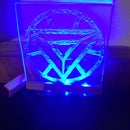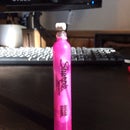Introduction: Water Gun Alarm Clock
I don't know about you, but I have trouble waking up...just about every day. The one thing that helps me actually wake up and get moving in the morning is a nice shower. But...what if you could be woken up by the water?!?!
That is what I attempted to build here. I have wanted to build this for a long time, its actually the idea that got me started in working with electronics. But I never got around to making it. Just recently I decided I wanted to get back into building things, and I decided to go ahead and build this: An alarm clock that shoots water at me while I am in bed. Biggest issue with something like this is that it tends to get a lot of things wet, like water tends to do. But it was still a fun project to build, and I hope the rest of you enjoy it as well.
What I did was take a motorized water gun, and a battery-operated alarm clock. And combine them into one awesome water-squirting alarm.
The materials that you will need for this project are as follows:
- Motorized (Electric) Water gun (Link Here)
- Battery Operated Alarm Clock (Any that you can tear apart will do)
- 6 Push Buttons (Linked Here)
- Jumper wire (Linked Here; Any 22 AWG wire will work)
- Project Enclosure (Linked Here)
- Empty Screw-top water bottle
The tools you will need are as follows:
- Soldering Iron (And Solder...)
- Hot Glue Gun
- Wire Stripper
- Drill
- Dremel
- Clamps
- And you may want a towel to clean up the water...it may get a little wet
Here is a video of the final product:
Step 1: Tearing Everything Apart
To start off you're going to want to take out the screws that hold together the motorized gun. There are a bunch of screws, and some are hard to see. Make sure you get them all. Once you get the screws all taken out pry open the gun. You should see all the parts, two motors (one for the pump and one for the spinning of the gun), then there should also be a circuit board. Later we are going to cut off most of the pieces of this gun, in order for it to fit in the project enclosure.
After getting open the gun, you'll next want to open up the alarm clock. There are only 3 screws for it, and it is easy to pry open. With the clock I ended up using, not the one pictured, there were two circuit boards. One was for the buttons, and one was the main controller. Make sure whatever setup yours has that you protect both circuit boards and watch where all the wires are located (Mine were flimsy and fell out really easily, knowing where they are will allow for you to solder them back together easily).
Also, keeping track of the screws isn't really necessary, you can save them. But for the most part we will not be needing them anymore.
Step 2: Setting Up the Circuit
Okay, so to get the actual circuitry up and running we need to first get access to the circuit boards of both devices. Then we need to use our multimeter to determine which wires correspond with what buttons on the alarm's circuit board, as well as the circuit board for the water gun. Then what we need to do is take the wires and desolder them from the board. Once the wires are desoldered we can resolver longer ones in their place. Then we can take them and do what we need with them.
What we need to do is to keep both battery packs connected separately. That way the gun has the same amount of power flowing to it without the interference of the alarm clock. This will allow for the battery life to last longer, and also allow for the gun to shoot its full capacity. In order for us to do this we will make use of the NPN transistor. The transistor will act as the switch from the alarm to the gun. When power runs from the alarm, it will engage the "switch" and allow for current to flow from VCC of the gun to GND of the gun, thus triggering the water squirting.
An NPN transistor works by having an "input" at the gate pin, which is in the center. When a small amount of voltage is applied the gate is engaged and connects the Collecter pin to the Emitter pin. The two wires that connect to the speaker from the alarm are VCC and GND. We are going to connect the VCC pin, red, to the gate on the transistor. Then we will take the GND wire (from the alarm) and the YELLOW wire (from the gun switch) and connect them to the Emitter on the transistor. Lastly we will connect VCC or RED on the gun switch to the COLLECTOR pin on the transistor. Then the main circuitry for the functionality is all done. Up next is rewiring the buttons from the alarm clock.
Step 3: Pushing Buttons...
For the buttons on the alarm I wanted to be able to rewire them and put them on the outside of the project enclosure. For this I determined what buttons were wired where on the circuit board. I then desoldered the wires and attached them to new ones in order to get longer leads. I then wired all the buttons together with GND. And took all the VCC leads and wired them individually. To determine what wires go where I took out my multimeter. I then used its continuity setting to figure out where each button went. First you have to find GND. Once GND is found you can push down each button to find which one is which. It may also work to just follow the traces on the PCB. Whichever works best for you.
Once you have all the buttons wired up, test each of them by powering on the alarm and pressing each of them to check the LCD and see if its working. Once they're all wired up you should be able to test the actual system. Power on the water gun and the clock. Then set the alarm for 1 minute after the current set time. After a minute of waiting the gun should start to shoot a pulsed stream of water. (Before doing this I'd recommend aiming the gun into a bucket or cup to contain the water (: )
Step 4: Project Enclosure/Water Reservoir
Next up was the hardest part for me. I've never done a project enclosure like this. And actually had so much trouble trying to make it look decent that I gave up and let it look like crap. First off I traced the size of the LCD and then taped the paper to the project box. I then took the grinding wheel and cut the size of the LCD hole. Next I took the drill and drilled out the hole where the gun nozzle is to be mounted. Lastly I cut the rectangle of the button board. Allowing enough room for the buttons to be protruding. Then I glued everything in place and was done.
But Wait!! How is the gun supposed to get water to shot out?! Well, utilizing the cartridge that ca,e with the water gun I was able to create a sealed reservoir for the water to be contained in. I took an empty water bottle and cut off the top. Then placed this over the top of the cartridge, attempting to fit it tightly over the O-ring seal. Then hot glued the in and outside of it to ensure it was water tight. Then I took the drill and drilled a hole in the lid of the bottle. This allowed for me to slide the tube, from the gun, through the cap. I then glued this to the cap. Then I can fill the cartridge with water and screw the lid on, knowing that no water will leak!
Once everything is all wired and mounted. Test out the new alarm clock water gun. It should be shooting water out at you after the set time period. If not, you may need to test your connections and do some re-wiring. Or there may even be a short somewhere. I hope you enjoyed my Intractable, please vote for it if you did. And check out some of my others. Thanks for reading!

Participated in the
Automation Contest

Participated in the
Move It













